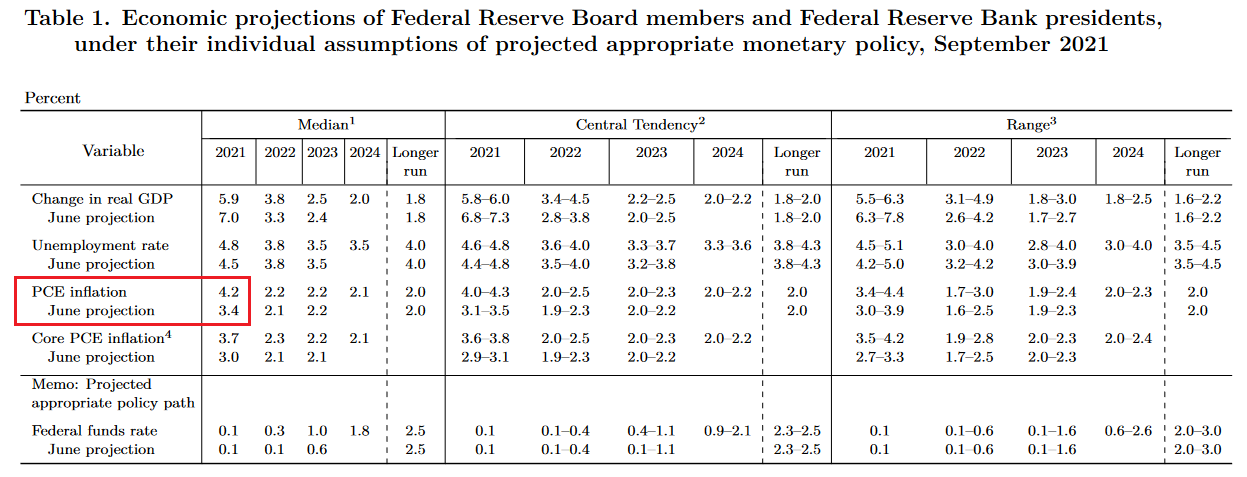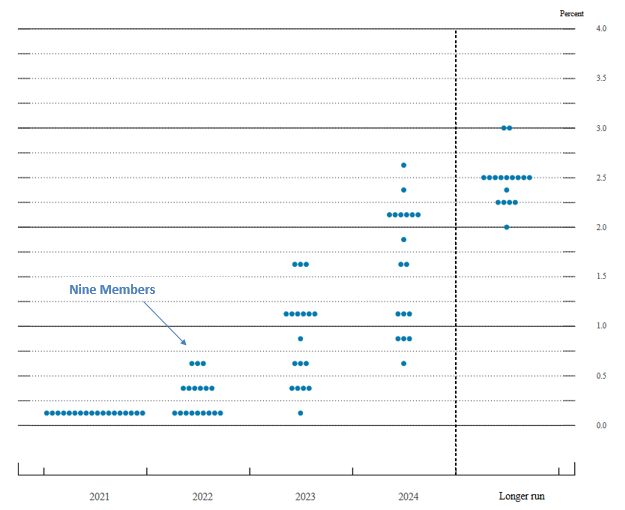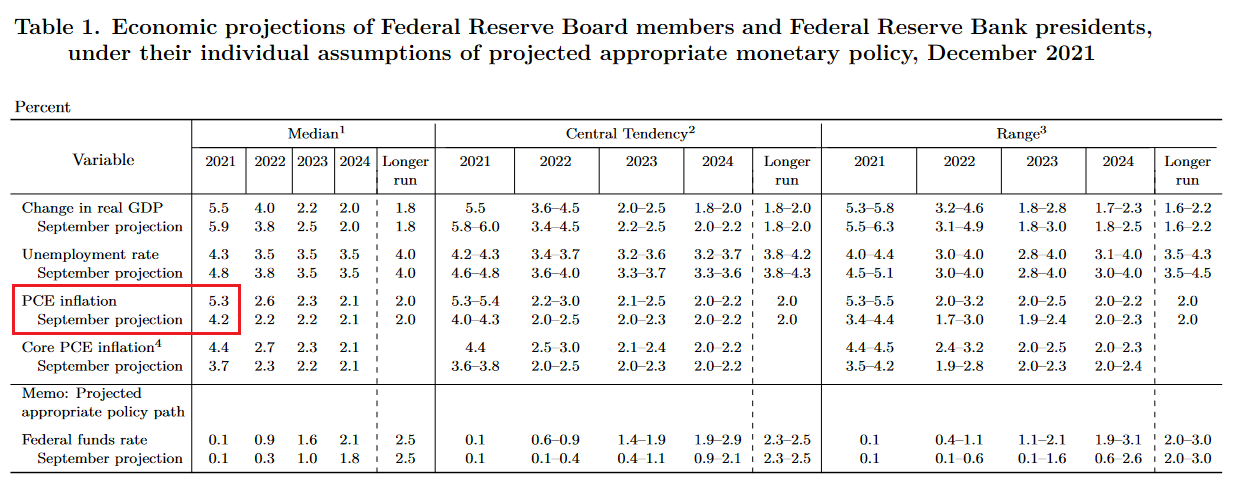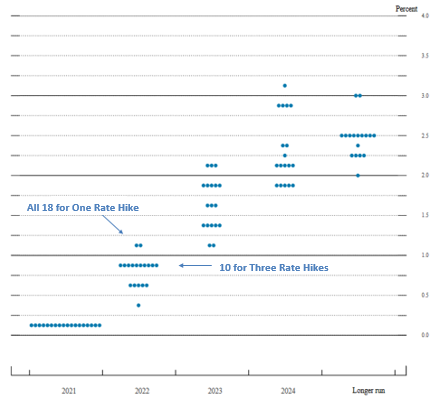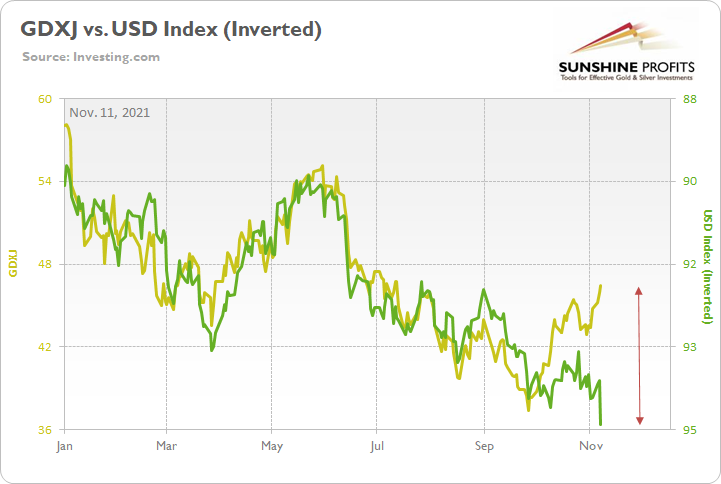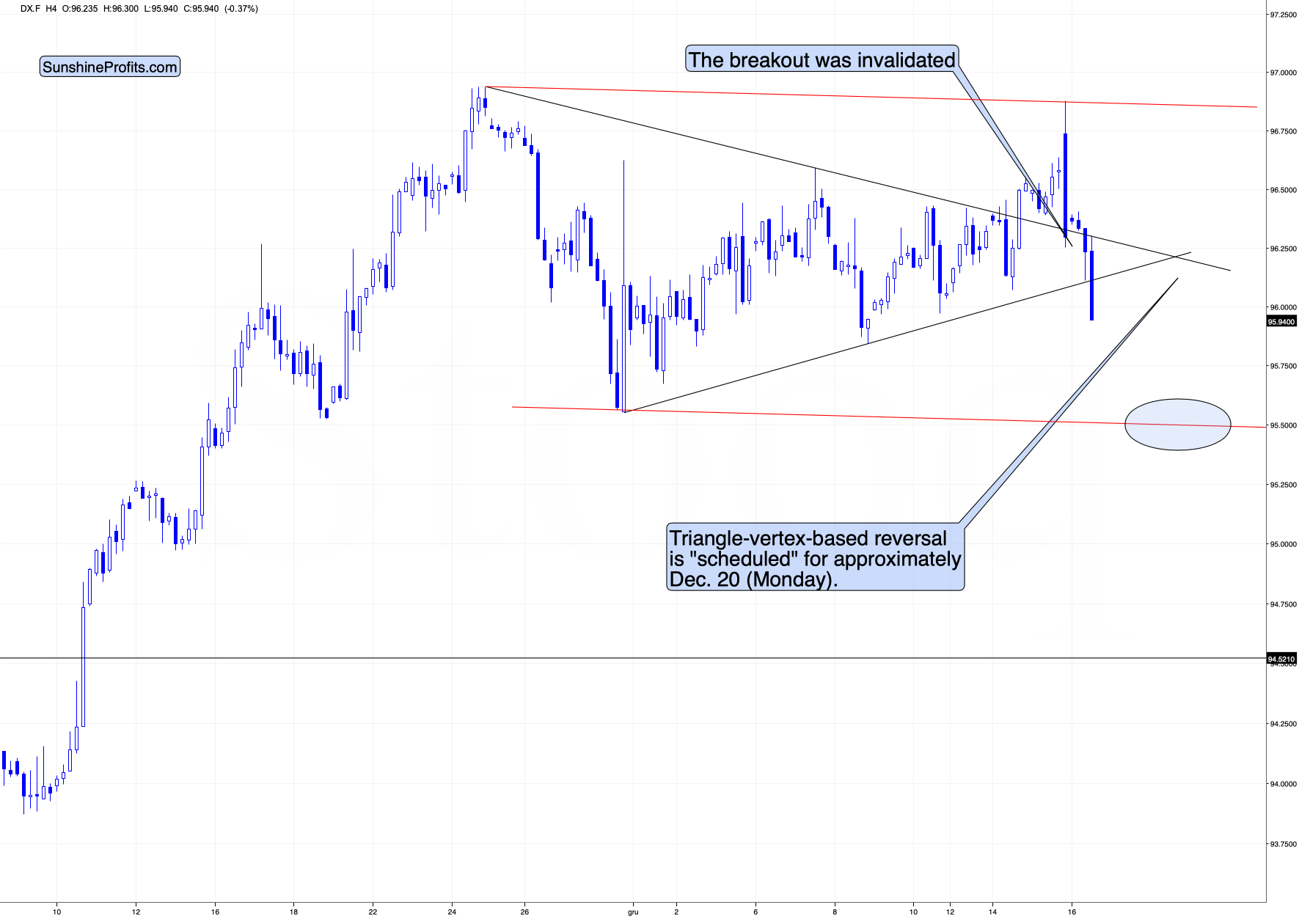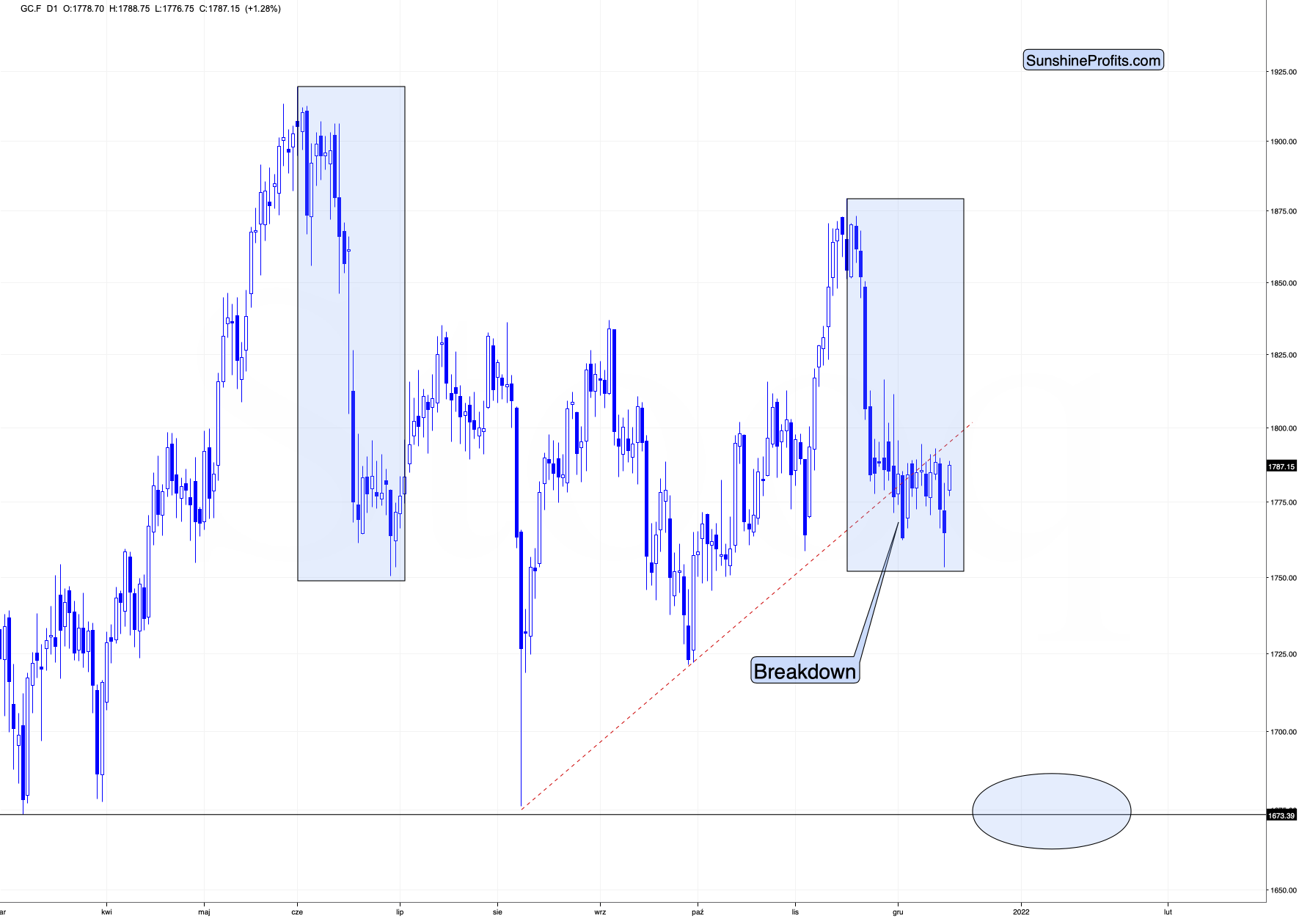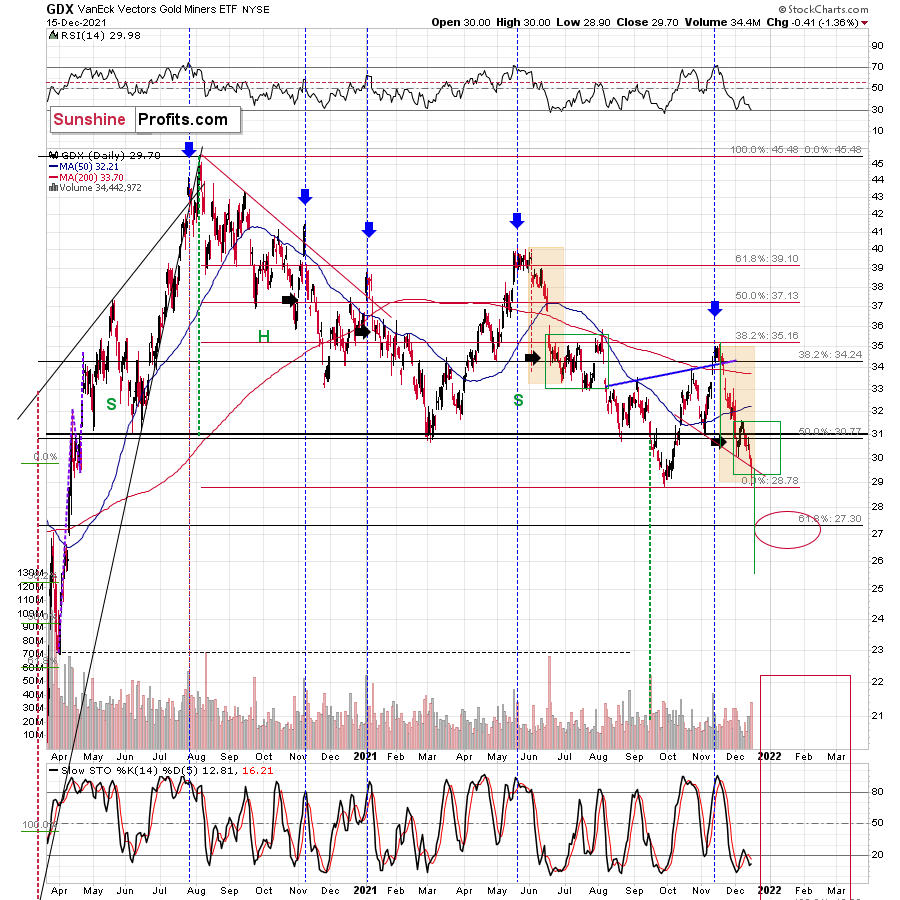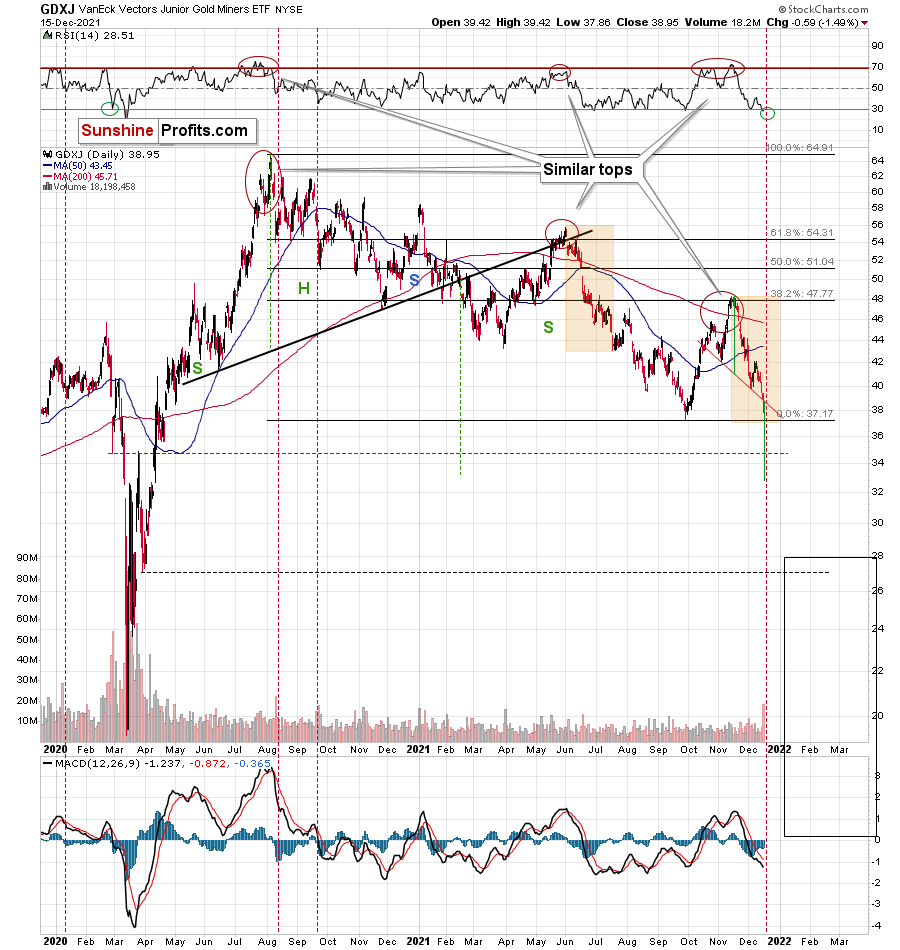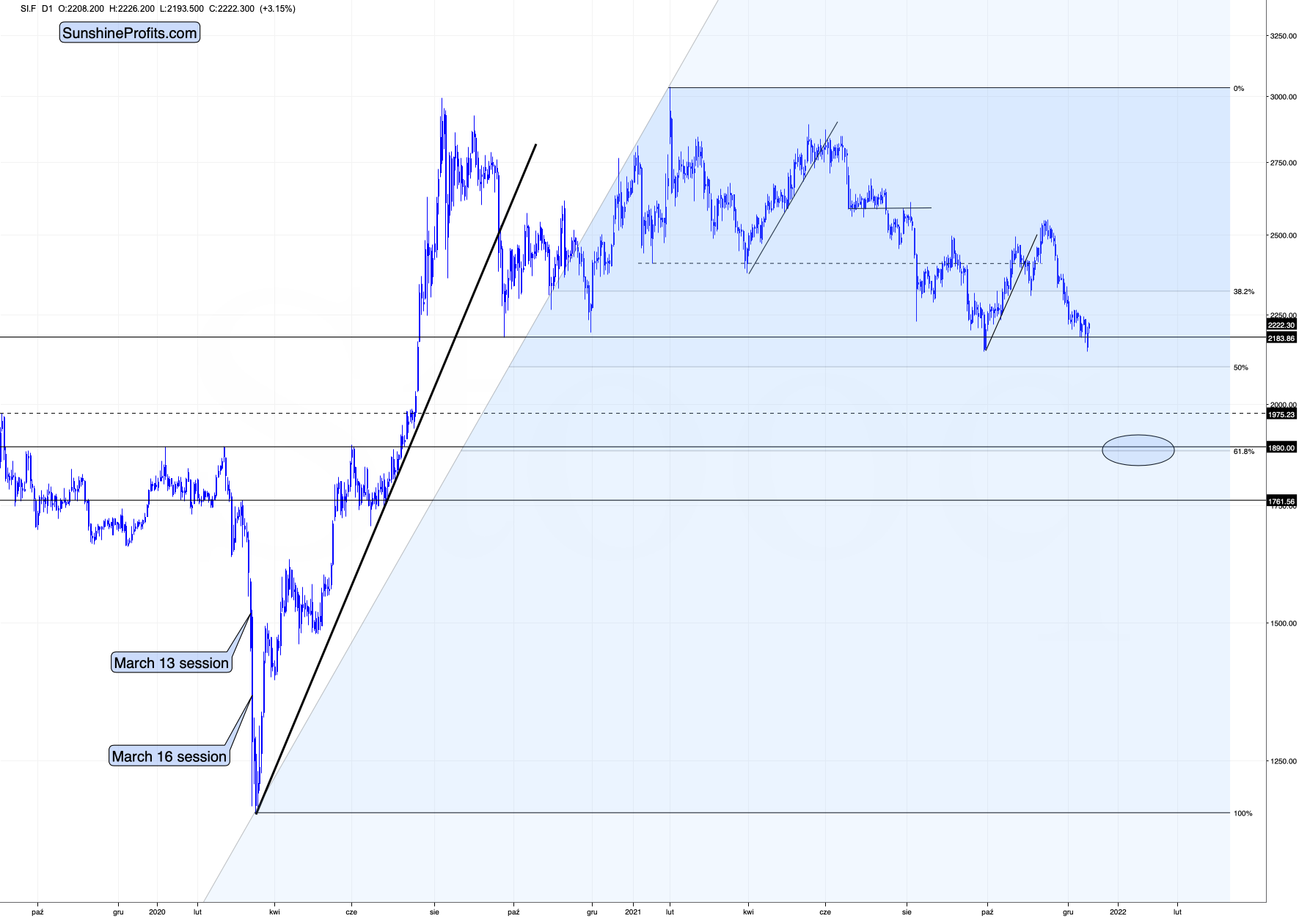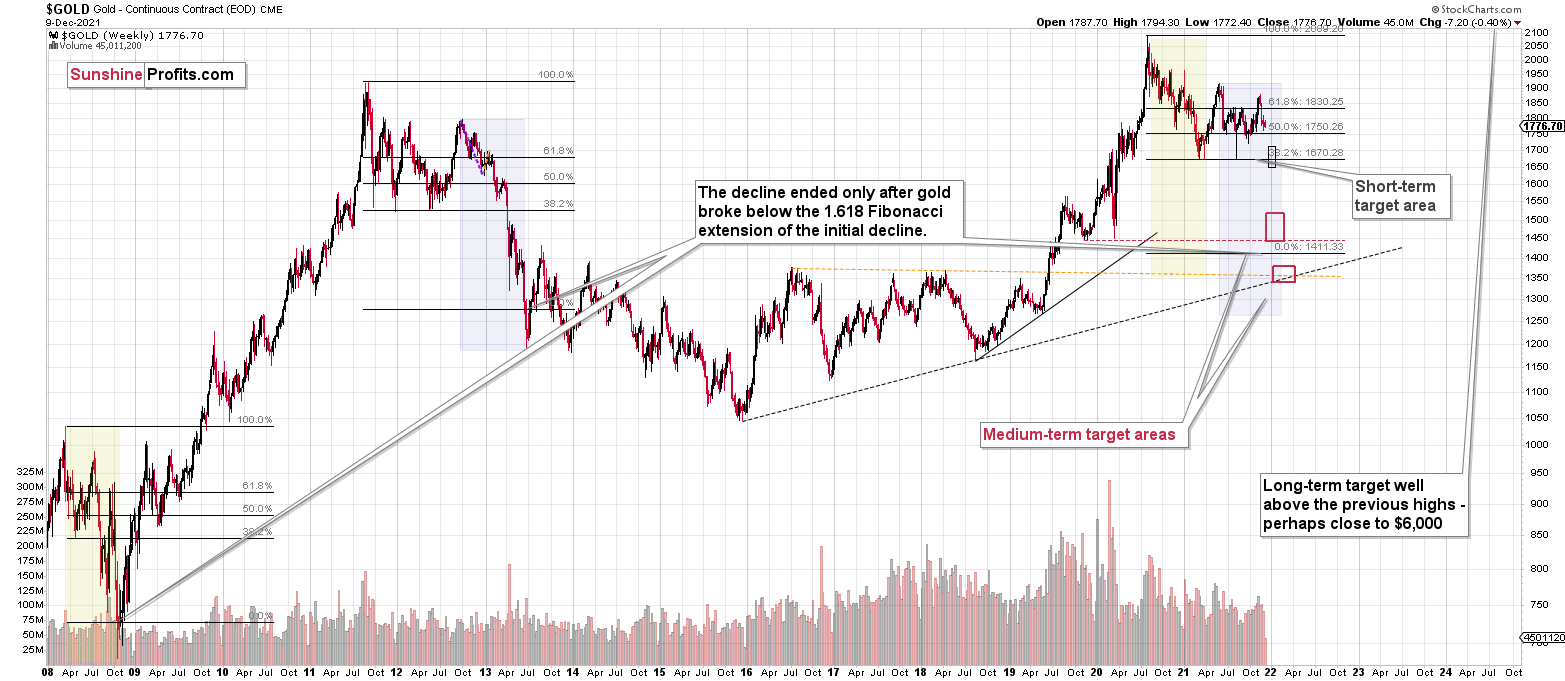Briefly: in our opinion, full (300% of the regular position size) speculative short positions in junior mining stocks are justified from the risk/reward point of view at the moment of publishing this Alert.
Yesterday’s price action was mostly about the Fed’s decision to accelerate tapering and much more hawkish narrative in general, so let’s start today’s analysis with a look at the fundamentals.
Tightening the Screws
While stock market investors orchestrated a ‘sell the rumor, buy the news’ reversal on Dec. 15, the PMs weren’t so lucky. Despite a late-afternoon surge by the S&P 500, gold, silver and mining stocks all ended the day in the red. Moreover, the weakness occurred even as the USD Index declined.
But what helped cause the profound underperformance?
Well, for starters, the Fed fired a hawkish bazooka on Dec. 15. To explain, the FOMC announced that it will increase the pace of its taper from $15 billion per month to $30 billion per month. An excerpt from its monetary policy statement read:
“In light of inflation developments and the further improvement in the labor market, the Committee decided to reduce the monthly pace of its net asset purchases by $20 billion for Treasury securities and $10 billion for agency mortgage-backed securities.”
Moreover, the hawkish crusade didn’t end there. However, to know where we’re going, it’s essential to know where we’ve been. For context, I wrote on Sept. 23:
While I’ve been warning for months that Powell remains materially behind the inflation curve, the FOMC increased its 2021 PCE Index projection from 3.4% YoY to 4.2% YoY and increased its 2022 projection by 10 basis points (0.10%) on Sep. 22. For context, the committee also reduced its 2021 real GDP growth forecast and increased its 2021 U.S. unemployment rate forecast (stagflation anyone?).
Please see below:
What’s more, the FOMC’s September ‘dot plot’ has nine FOMC participants signaling at least one rate hike in 2022 and 17 FOMC participants signaling at least one rate hike in 2023.
Please see below:
To explain, the vertical scale on the right side of the chart represents the U.S. federal funds rate and the blue dots depict Fed officials’ projections for the rate and when they will likely materialize. If you analyze the arrow near the left side of the chart, you can see that nine members expect the U.S. federal funds rate to range between roughly 0.25% and 0.75% in 2022. In addition, 17 Fed officials expect the U.S. federal funds rate to range between roughly 0.25% and 1.75% in 2023. Thus, surging inflation has the FOMC increasingly hawked up.
And now, with the FOMC releasing its latest Summary of Economic Projections on Dec. 15, officials’ 2021 PCE Index estimate has increased from 4.2% YoY to 5.3% YoY and its 2022 estimate has increased by 40 basis points (0.40%).
Please see below:
However, the crucial development was the hawkish change in the FOMC’s dot plot. With all 18 members now expecting at least one rate hike in 2022, the median forecast (10 dots = 10 members) is for three rate hikes in 2022.
Please see below:
On top of that, when Chairman Jerome Powell was asked if he postponed his “hawkish policy stance” until after he was reappointed for a second term, he responded:
“We got the labor market report two days after the [November] meeting, and then one week after that, we got the CPI reading.… I just came to the view over that weekend that we needed to speed up the taper and we started working on that. That’s a full 10 days or so before the president made a decision to re-nominate me. So, honestly, it had nothing to do with that at all.”
However, as one of the most important quotes of the press conference, he admitted:
“My colleagues were out talking about a faster taper and that doesn’t happen by accident. They were out talking about a faster taper before the president made his decision. So it’s a decision that effectively was more than entrained.”
And while Powell sounded a little rattled during the exchange, his slip highlights the importance of Fed officials’ hawkish rhetoric. Essentially, when Clarida, Waller, Bostic, Bullard, etc., are making the hawkish rounds, “that doesn’t happen by accident.” As such, it’s an admission that his understudies serve as messengers for pre-determined policy decisions.
Also noteworthy, Powell admitted that inflationary risks have increased and that the jump in the 2022 PCE Index projection was a “pretty significant move up.” He said:
“There is a real risk now that inflation may be more persistent and that may be putting inflation expectations under pressure, and that the risk of higher inflation becoming entrenched has increased. It’s certainly increased. I don’t think it’s high at this moment. But I think it’s increased and I think that’s part of the reason behind our move today.”
More importantly, though, with boiling inflation colliding with a lukewarm labor market, Powell said that “one of the two big threats to getting back to maximum employment is actually high inflation.”
As a result, the narrative has been flipped upside down. Before, dovish policy was required to help uplift the consumer and heal the U.S. economy. Now, with consumer confidence near a 10-year low, hawkish policy is required to help uplift the consumer and heal the U.S. economy.
Thus, the PMs remain in no man’s land. For context, I warned on Nov. 11 that the Fed would spoil the PMs’ party. And with the GDXJ ETF now approaching its 2021 lows, investors have come around to our way of thinking. I wrote:
With inflation surging, markets rattled, The White House rattled and precious metals investors assuming that policymakers will do nothing (even as their anxiety accelerates), the calculus boils down to one fundamental question: do you believe the U.S. dollar or do you believe the PMs?
Please see below:
To explain, the gold line above tracks the GDXJ ETF (our short position) in 2021, while the green line above tracks the inverted (scale flipped upside down) USD Index. If you analyze the relationship, you can see that when the USD Index rises (the green line falls), the GDXJ ETF often heads in the opposite direction.
However, with the U.S. dollar betting that the Fed will tighten and the junior miners betting that it won’t, we expect the former to win out over the medium term.
The bottom line? When the Fed drops the hawkish hammer, it shakes the PMs’ fundamental foundation. For example, surging inflation led to an upgrade of the FOMC’s PCE Index projection. Then, it led to a taper announcement being pulled forward by several months. Now, it’s led to an accelerated taper and has the majority of FOMC officials signaling three rate hikes in 2022.
And keep in mind: the accelerated taper will have little effect on inflation in the near term. In reality, the liquidity deceleration will take months to filter through the real economy. As a result, more hot CPI prints will likely hit the wire in the coming months and don’t be surprised if Fed officials ramp up the hawkish rhetoric in 2022. Because, as Powell admitted, “that doesn’t happen by accident.”
In conclusion, the PMs declined on Dec. 15, and silver was the daily underperformer. And while the USD Index declined as well, ‘selling the news’ is a game that day traders like to play. Despite that, though, the greenback’s fundamentals are stronger now than at any other point in 2021. And with the FOMC poised to up the hawkish ante over the medium term, a stronger U.S. dollar and rising real interest rates will likely chip away at the PMs’ prices over the next few months.
On the Technical Front
The question is if it was only the USD Index that got ahead of itself in a buy-the-rumor-sell-the-fact manner, or does the same apply to the precious metals market as well.
In my opinion, gold, silver, and miners were affected too, and we have already seen a small corrective upswing. I know that some of you have already taken profits from your short positions in the precious metals sector, but the question remains: what’s next? Are short positions still justified, or not?
Before replying to these questions, let’s take a look at the USD Index.
In short, yesterday’s intraday breakout above the triangle pattern was invalidated and since invalidations are bearish signals, it’s no wonder that it was followed by lower USDX values.
The immediate-term momentum in the USDX is down. But the late-November lows or the red support line that’s very close to them is likely to stop the decline.
Why? Because that’s the closest relatively strong short-term support level. It’s also possible that the USDX would bottom higher. I don’t think that the USD Index would be likely to fall much lower, as the fundamental situation is still bullish for the USDX (there are more monetary hawks in the U.S. then they are in the Eurozone and Japan), and the medium-term trend remains up.
Given how far the USD Index declined from its very recent high, the above means that the USD Index would be likely to decline by not more than it had already declined recently.
Let’s see how gold and mining stocks reacted.
Well, gold moved visibly higher from the recent lows, but:
- It hasn’t invalidated its previous breakdown below the rising red support line
- Even if the size of the very recent rally doubled, gold would not move up that significantly – perhaps to $1,815 or so.
There’s also a risk that gold might rally more visibly because of the similarity to what happened earlier this year. I marked both cases with blue rectangles. After making a second lower bottom, gold rallied and most of the upswing happened in July 2020.
But how much did the mining stocks rally in July?
Please take a look at the areas marked with green rectangles. There was a tiny rally in July 2020, but it was nothing significant, unless one was engaged in day-trading or very short-term trading.
While gold corrected about half of its preceding decline (in July), GDX didn’t. And what did junior miners do at that time?
Well, they did even less.
The “rally” in junior miners was barely noticeable – it’s all part of a broader downtrend that started in early June and ended in late September.
Also, please note that the volume on which the GDXJ ETF declined/reversed yesterday was huge. When we previously saw similar volume spikes (marked with vertical, red, dashed lines), GDXJ then moved higher in the short term only to decline to new lows in the medium term.
Still, let’s keep in mind that in early 2020 that preceded the huge slide, and in mid-2020 that was very close after the major top, so I wouldn’t say that those mid-2020 cases are analogous to the current situation (in terms of context), and in case of the early-2020 analogy, if the history repeats itself, it might be better to simply stick to the short position in order to be sure not to miss the really big move.
So, will we see a rebound here? That’s probably going to be the case. Will it be significant? That depends.
It might be quite visible in case of gold, but not necessarily in case of mining stocks.
In fact, at the moment of writing these words, gold is trading very close to its December highs, while the GDXJ (in London trading) corrected about 23.6% of the entire December decline.
Consequently, if I had a short position in gold, I would probably close it right now in order to re-enter it at higher prices, but since I don’t have one, but I have a short position in junior mining stocks, I’m choosing to keep it intact and wait out the possible correction.
This might change IF we see strength in mining stocks vs. gold, but we’re not seeing it so far today.
And what about silver?
Like mining stocks, silver did not move back to its previous December highs. Consequently, I wouldn’t bet the farm on a major rally in the price of the white precious metal. Instead, a smaller corrective upswing appears more likely. If I had a short position in silver (and I don’t), I would probably not have exited it right now.
Overview of the Upcoming Part of the Decline
- It seems to me that while we might see a corrective upswing here, it might not be significant in case of junior mining stocks. After the corrective upswing is over, I think that gold will decline once again taking silver and mining stocks lower as well.
- It seems that the first stop for gold will be close to its previous 2021 lows, slightly below $1,700. Then it will likely correct a bit, but it’s unclear if I want to exit or reverse the current short position based on that – it depends on the number and the nature of the bullish indications that we get at that time.
- After the above-mentioned correction, we’re likely to see a powerful slide, perhaps close to the 2020 low ($1,450 - $1,500).
- If we see a situation where miners slide in a meaningful and volatile way while silver doesn’t (it just declines moderately), I plan to – once again – switch from short positions in miners to short positions in silver. At this time, it’s too early to say at what price levels this could take place, and if we get this kind of opportunity at all – perhaps with gold close to $1,600.
- I plan to exit all remaining short positions once gold shows substantial strength relative to the USD Index while the latter is still rallying. This may be the case with gold close to $1,350 - $1,400. I expect silver to fall the hardest in the final part of the move. This moment (when gold performs very strongly against the rallying USD and miners are strong relative to gold after its substantial decline) is likely to be the best entry point for long-term investments, in my view. This can also happen with gold close to $1,375, but at the moment it’s too early to say with certainty. I expect the final bottom to take place near the end of the year, perhaps in mid-December. It is not set in stone that PMs have to bottom at that time. If not then, then early 2022 would become a likely time target.
- As a confirmation for the above, I will use the (upcoming or perhaps we have already seen it?) top in the general stock market as the starting point for the three-month countdown. The reason is that after the 1929 top, gold miners declined for about three months after the general stock market started to slide. We also saw some confirmations of this theory based on the analogy to 2008. All in all, the precious metals sector is likely to bottom about three months after the general stock market tops. The additional confirmation will come from the tapering schedule, as markets are likely to move on the rumor and reverse on the fact as they tend to do in general.
- The above is based on the information available today, and it might change in the following days/weeks.
You will find my general overview of the outlook for gold on the chart below:
Please note that the above timing details are relatively broad and “for general overview only” – so that you know more or less what I think and how volatile I think the moves are likely to be – on an approximate basis. These time targets are not binding or clear enough for me to think that they should be used for purchasing options, warrants or similar instruments.
Letters to the Editor
Q: PR, Do you plan on hedging your long term holdings in anticipation of corrections during the upcoming bull market in gold? Thanks!
A: That depends on how one views their portfolio. From the total portfolio’s point of view, I’m “hedging” the long-term investment capital by entering a short position in the trading capital (on the same instrument or something that’s highly correlated with the long-term investment). In this way, yes, I plan to hedge the long-term investments in precious metals.
Summary
Summing up, it seems to me that while we might see a corrective upswing here, it might not be significant in case of junior mining stocks. After the corrective upswing is over, I think that gold will decline once again taking silver and mining stocks lower as well.
If the new Covid-19 variant makes the vaccine rather useless, we might be in for very wild price moves in most markets. In the case of the precious metals sector, the initial move should be to the downside, but at the same time, it makes the long-term outlook even more bullish.
From the medium-term point of view, the key two long-term factors remain the analogy to 2013 in gold and the broad head and shoulders pattern in the HUI Index. They both suggest much lower prices ahead.
It seems that our profits from the short positions are going to become truly epic in the following months.
After the sell-off (that takes gold to about $1,350 - $1,500), I expect the precious metals to rally significantly. The final part of the decline might take as little as 1-5 weeks, so it's important to stay alert to any changes.
Most importantly, please stay healthy and safe. We made a lot of money last March and this March, and it seems that we’re about to make much more on the upcoming decline, but you have to be healthy to enjoy the results.
As always, we'll keep you - our subscribers - informed.
By the way, we’re currently providing you with the possibility to extend your subscription by a year, two years or even three years with a special 20% discount. This discount can be applied right away, without the need to wait for your next renewal – if you choose to secure your premium access and complete the payment upfront. The boring time in the PMs is definitely over, and the time to pay close attention to the market is here. Naturally, it’s your capital, and the choice is up to you, but it seems that it might be a good idea to secure more premium access now while saving 20% at the same time. Our support team will be happy to assist you in the above-described upgrade at preferential terms – if you’d like to proceed, please contact us.
To summarize:
Trading capital (supplementary part of the portfolio; our opinion): Full speculative short positions (300% of the full position) in junior mining stocks are justified from the risk to reward point of view with the following binding exit profit-take price levels:
Mining stocks (price levels for the GDXJ ETF): binding profit-take exit price: $35.73; stop-loss: none (the volatility is too big to justify a stop-loss order in case of this particular trade)
Alternatively, if one seeks leverage, we’re providing the binding profit-take levels for the JDST (2x leveraged) and GDXD (3x leveraged – which is not suggested for most traders/investors due to the significant leverage). The binding profit-take level for the JDST: $16.18; stop-loss for the JDST: none (the volatility is too big to justify a SL order in case of this particular trade); binding profit-take level for the GDXD: $32.08; stop-loss for the GDXD: none (the volatility is too big to justify a SL order in case of this particular trade).
For-your-information targets (our opinion; we continue to think that mining stocks are the preferred way of taking advantage of the upcoming price move, but if for whatever reason one wants / has to use silver or gold for this trade, we are providing the details anyway.):
Silver futures downside profit-take exit price: $19.12
SLV profit-take exit price: $17.72
ZSL profit-take exit price: $41.38
Gold futures downside profit-take exit price: $1,683
HGD.TO – alternative (Canadian) inverse 2x leveraged gold stocks ETF – the upside profit-take exit price: $12.48
HZD.TO – alternative (Canadian) inverse 2x leveraged silver ETF – the upside profit-take exit price: $30.48
Long-term capital (core part of the portfolio; our opinion): No positions (in other words: cash
Insurance capital (core part of the portfolio; our opinion): Full position
Whether you already subscribed or not, we encourage you to find out how to make the most of our alerts and read our replies to the most common alert-and-gold-trading-related-questions.
Please note that we describe the situation for the day that the alert is posted in the trading section. In other words, if we are writing about a speculative position, it means that it is up-to-date on the day it was posted. We are also featuring the initial target prices to decide whether keeping a position on a given day is in tune with your approach (some moves are too small for medium-term traders, and some might appear too big for day-traders).
Additionally, you might want to read why our stop-loss orders are usually relatively far from the current price.
Please note that a full position doesn't mean using all of the capital for a given trade. You will find details on our thoughts on gold portfolio structuring in the Key Insights section on our website.
As a reminder - "initial target price" means exactly that - an "initial" one. It's not a price level at which we suggest closing positions. If this becomes the case (like it did in the previous trade), we will refer to these levels as levels of exit orders (exactly as we've done previously). Stop-loss levels, however, are naturally not "initial", but something that, in our opinion, might be entered as an order.
Since it is impossible to synchronize target prices and stop-loss levels for all the ETFs and ETNs with the main markets that we provide these levels for (gold, silver and mining stocks - the GDX ETF), the stop-loss levels and target prices for other ETNs and ETF (among other: UGL, GLL, AGQ, ZSL, NUGT, DUST, JNUG, JDST) are provided as supplementary, and not as "final". This means that if a stop-loss or a target level is reached for any of the "additional instruments" (GLL for instance), but not for the "main instrument" (gold in this case), we will view positions in both gold and GLL as still open and the stop-loss for GLL would have to be moved lower. On the other hand, if gold moves to a stop-loss level but GLL doesn't, then we will view both positions (in gold and GLL) as closed. In other words, since it's not possible to be 100% certain that each related instrument moves to a given level when the underlying instrument does, we can't provide levels that would be binding. The levels that we do provide are our best estimate of the levels that will correspond to the levels in the underlying assets, but it will be the underlying assets that one will need to focus on regarding the signs pointing to closing a given position or keeping it open. We might adjust the levels in the "additional instruments" without adjusting the levels in the "main instruments", which will simply mean that we have improved our estimation of these levels, not that we changed our outlook on the markets. We are already working on a tool that would update these levels daily for the most popular ETFs, ETNs and individual mining stocks.
Our preferred ways to invest in and to trade gold along with the reasoning can be found in the how to buy gold section. Furthermore, our preferred ETFs and ETNs can be found in our Gold & Silver ETF Ranking.
As a reminder, Gold & Silver Trading Alerts are posted before or on each trading day (we usually post them before the opening bell, but we don't promise doing that each day). If there's anything urgent, we will send you an additional small alert before posting the main one.
Thank you.
Przemyslaw Radomski, CFA
Founder, Editor-in-chief


